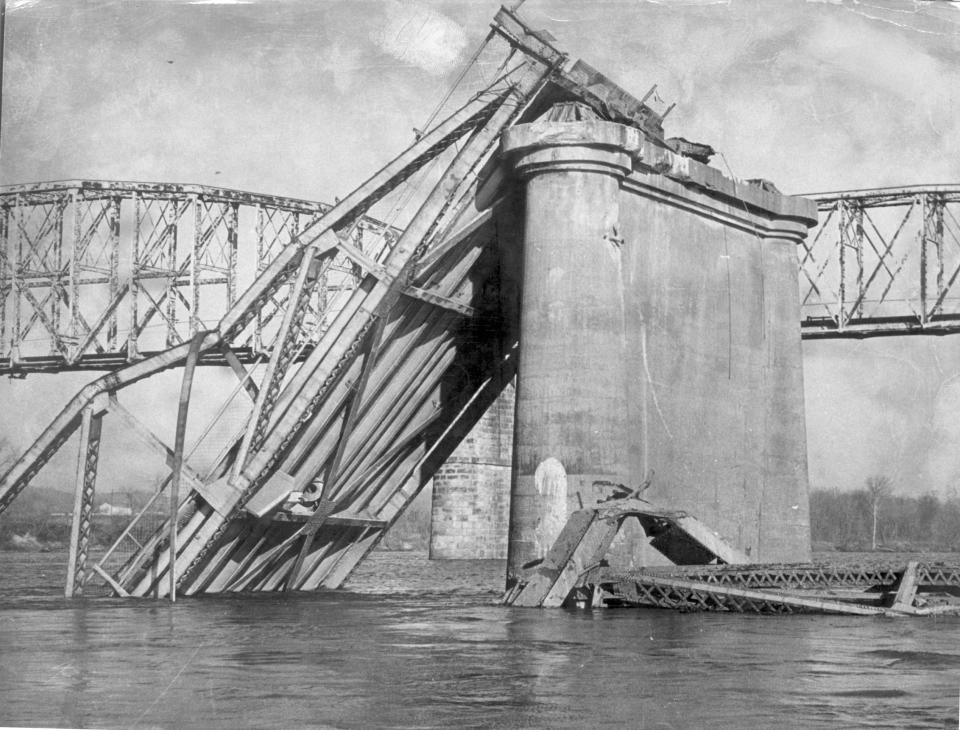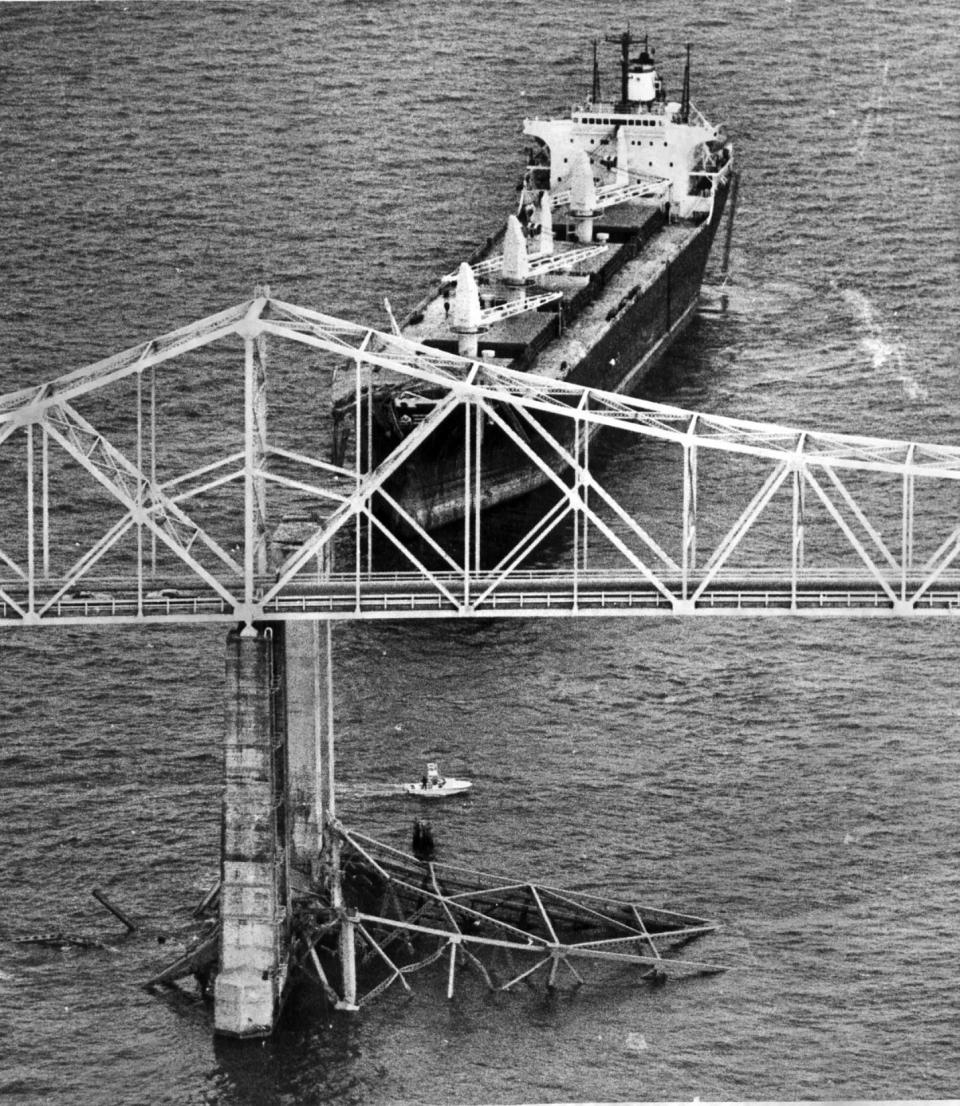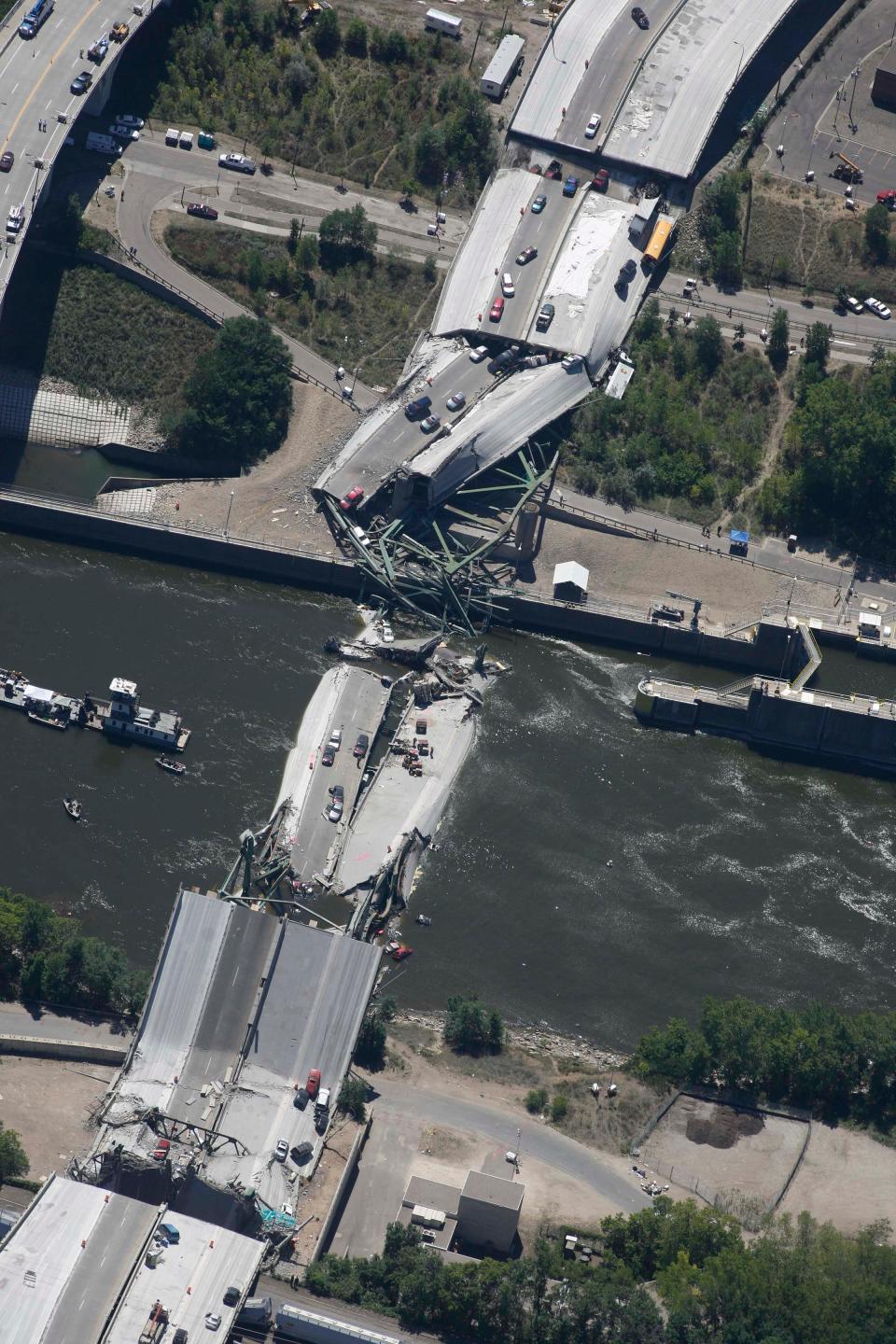Baltimore's Key Bridge is not the first: A look at other bridge collapse events in US history
Parts of the 1.6-mile, four-lane Francis Scott Key Bridge in Baltimore, Maryland, collapsed into the Patapsco River after it was struck by a large cargo ship Tuesday morning.
Local, state and federal crews responded to the collapse and were searching for six construction workers who were on the bridge when the ship struck. Two people were rescued in the initial hours of the search: one unharmed and the other in "very serious condition," said James Wallace, chief of the Baltimore City Fire Department.
The Dali, the container vessel, was chartered by the major shipping company Maersk and was carrying its cargo, according to a statement from the company. It was slated to arrive early April in Sri Lanka, according to MarineTraffic, a global ship tracking service.
The bridge is not the first to have collapsed in the past 100 years. Here's a look at bridge collapses in recent U.S. history.
Live updates: Baltimore's Key Bridge collapses after ship collision; 2 rescued, search continues
1967: Point Pleasant Bridge in West Virginia

The Point Pleasant Bridge, colloquially known as the Silver Bridge for its aluminum paint, collapsed during heavy rush hour traffic on Dec. 15, 1967.
The 2,200-foot suspension bridge carried U.S. Route 35 and spanned the Ohio River, connecting Point Pleasant, West Virginia, and Gallipolis, Ohio. Forty-six people died in the collapse, and two of those people were never found.
An investigation found the collapse was caused by a failure of one eyebar chain that had been noted in a preliminary report 10 months earlier.
The collapse led to federal regulations on the inspection of bridges and an increased emphasis on bridge safety through the Federal-Aid Highway Act of 1968, which established a National Bridge Inspection Program.
1980: Sunshine Skyway bridge in Florida

In 1980, the Sunshine Skyway bridge collapsed after it was struck by a ship. Thirty-five motorists and bus passengers were killed.
A 1,200-foot chunk of the bridge, which connected St. Petersburg and Bradenton, collapsed after the massive Summit Venture freighter slammed into one of its central support piers.
When a section of the bridge fell into Tampa Bay, it took a truck, seven cars and a Greyhound bus with it.
The Herald-Tribune, part of the USA TODAY Network, reported the crash happened during an intense thunderstorm, with winds reaching 80 mph and heavy rain. Visibility was near zero, according to local historians who made a documentary film about the collapse.
After the collapse, the freighter remained stuck beneath the bridge, with part of the roadway on its bow. Photos from the time show how one motorist was able to stop his car just inches from where the bridge fell into the water.
1993: Big Bayou Canot Bridge in Alabama
On Sept. 22, 1993, barges pushed by a towboat collided with the Big Bayou Canot Bridge near Mobile, Alabama. Just eight minutes later, an Amtrak passenger train derailed from the bridge. Forty-seven people were killed 103 were injured.
The towboat pushing the barge had made a wrong turn on the Mobile River and entered the Big Bayou Canot. In heavy fog, the towboat's pilot, Willie Odom, struck the bridge, which forced the end of the bridge span out of alignment by about 3 feet and kinked the track.
The accident is the deadliest train wreck in Amtrak's history and in Alabama railway history.
2002: 1-40 bridge collapse in Oklahoma
The I-40 bridge, which spanned the Arkansas River just southeast of Webbers Falls, Oklahoma, collapsed on May 26, 2002, after a freight barge struck a pier supporting the bridge.
The captain of the barge's towboat reportedly lost consciousness, and the barge lost control and crashed into the pier support.
A section of the bridge collapsed, and 14 people were killed.
Victims and families settled a lawsuit with the towboat company, Magnolia Marine Transport Co., in May 2003 for an undisclosed amount.
Crews took about two months to rebuild the bridge ? the estimate had been six months ? and traffic resumed in July 2002.
2007: Mississippi River bridge in Minnesota

The I-35W Mississippi River bridge, also known as Bridge 940, spanned the Mississippi River just downstream from Minneapolis.
At the time, it was the third-busiest bridge in Minnesota, carrying about 140,000 vehicles a day.
It collapsed into the Mississippi River during the evening rush hour on Aug. 1, 2007, killing 13 people and injuring 145.
Several reports had cited problems with the bridge, and in 2005 it was given a rating of "structurally deficient" and possibly in need of replacement, according to the U.S. Department of Transportation. Construction had been taking place on the bridge weeks before, including joint work and replacement of lighting, concrete and guard rails.
According to an investigation by the National Transportation Safety Board, the collapse was probably the result of a design flaw from thin steel gusset plates that helped connect steel beams.
2024: Bridge partially collapses in China
In the early morning of Feb. 22, a part of the bridge over China’s Pearl River in Guangzhou collapsed after a container ship collided with the bridge. Five people died and three were injured.
Four vehicles and one electric motorcycle fell off the bridge after the collision. The dead included a driver of an empty bus, the driver of the motorcycle and three people in trucks that went into the river, according to city officials.
“Improper operations” by the ship’s crew caused the collision, according to officials at the city’s press conference.
The container ship Lianghui 688 collided with the Lixinsha Bridge twice while navigating through the waterway. The city official said the ship hit adjacent bridge piers, leading to the rupture of the bridge deck over the space between the piers.
Based on reports obtained by online news platform Jimu News, the ship measured about 197 feet in length and 59 feet in height and transmitted its final position around 5:29 a.m. on Feb. 22.
Weibing Peng, an expert on bridge construction and collapse incidents from Zhejiang University of Technology analyzed the incident and told Jimu News that the ship first hit one pier on a diagonal course, then swung nearly parallel to the bridge and hit a second pier. The second pier tilted, resulting in the partial collapse of the bridge.
Contributing: Claire Thornton and Dian Zhang, USA TODAY
This article originally appeared on USA TODAY: US bridge collapses: Baltimore's Key Bridge not the first disater
